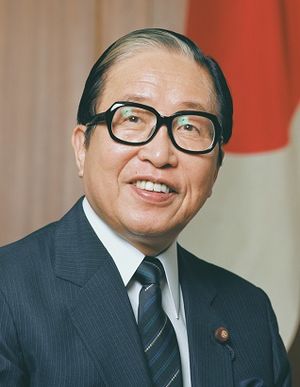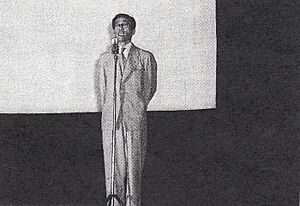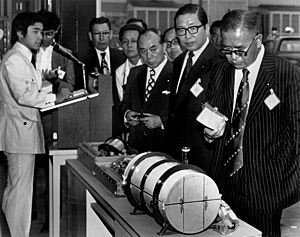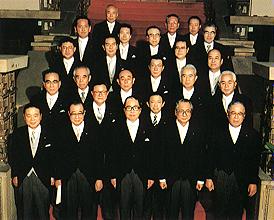Sōsuke Uno facts for kids
Quick facts for kids
Sōsuke Uno
|
|
|---|---|
|
宇 野 宗 佑
|
|
 |
|
| Prime Minister of Japan | |
| In office 3 June 1989 – 10 August 1989 |
|
| Monarch | Akihito |
| Preceded by | Noboru Takeshita |
| Succeeded by | Toshiki Kaifu |
| Minister for Foreign Affairs | |
| In office 8 November 1987 – 3 June 1989 |
|
| Prime Minister | Noboru Takeshita |
| Preceded by | Tadashi Kuranari |
| Succeeded by | Hiroshi Mitsuzuka |
| Minister of International Trade and Industry | |
| In office 10 June 1983 – 27 November 1983 |
|
| Prime Minister | Yasuhiro Nakasone |
| Preceded by | Sadanori Yamanaka |
| Succeeded by | Hikosaburo Okonogi |
| Director General of the Administrative Management Agency | |
| In office 9 November 1979 – 17 July 1980 |
|
| Prime Minister | Masayoshi Ōhira |
| Preceded by | Motohiko Kanai |
| Succeeded by | Yasuhiro Nakasone |
| Director General of the Science and Technology Agency | |
| In office 24 December 1976 – 28 November 1977 |
|
| Prime Minister | Takeo Fukuda |
| Preceded by | Masao Maeda |
| Succeeded by | Tasaburo Kumagai |
| Director General of the Japan Defense Agency | |
| In office 11 November 1974 – 9 December 1974 |
|
| Prime Minister | Kakuei Tanaka |
| Preceded by | Sadanori Yamanaka |
| Succeeded by | Michita Sakata |
| Member of the House of Representatives | |
| In office 20 November 1960 – 20 October 1996 |
|
| Personal details | |
| Born | 27 August 1922 Moriyama, Shiga, Empire of Japan |
| Died | 19 May 1998 (aged 75) Moriyama, Shiga, Japan |
| Political party | Liberal Democratic Party |
| Alma mater | Kobe University of Commerce |
| Signature |  |
| Military career | |
| Allegiance | |
| Service/ |
|
| Years of service | 1943–45 |
| Rank | Second Lieutenant |
| Battles/wars | Second World War
|
Sōsuke Uno (宇野 宗佑, Uno Sōsuke, 27 August 1922 – 19 May 1998) was a Japanese politician who served as the Prime Minister of Japan for a short time in 1989. He was the first Prime Minister to come from Shiga Prefecture. Uno's time as Prime Minister was brief, lasting only sixty-eight days, due to a public controversy.
Contents
Early Life and Education
Sōsuke Uno was born in Moriyama, Shiga, Japan. His family owned a traditional Japanese rice wine (sake) brewery called Arachō. His family had also served as important local officials for many years.
In 1943, Uno finished his studies at Hikone Commercial College. He was a champion in Kendo, a Japanese martial art, leading his college team to a national title. He then went to Kobe College of Commerce. However, he had to leave after only two months. He was called to join the Imperial Japanese Army as an officer during World War II.
After the war ended, Uno was sent to Siberia as a prisoner. He later wrote a famous book in Japan about his experiences during this difficult time. He never returned to Kobe College of Commerce.
Political Career
Sōsuke Uno began his political journey in 1960. He was elected to the Diet of Japan, which is Japan's parliament. Over the years, he took on many important roles in the government.
He served as Vice-Minister in the Ministry of International Trade and Industry. He also held similar positions in the Science and Technology Agency and the Administrative Agency. Eventually, he became a full Cabinet Minister. He was the Minister for Trade and Industry, and later the Foreign Secretary.
As Foreign Secretary, Uno was praised for his skill. He managed to balance Japan's interests with international demands for more trade. In 1974, he briefly led Japan's defense agency. He was also the first Japanese Cabinet member to visit Israel since 1973.
Uno became Prime Minister during a challenging time for his political party, the Liberal Democratic Party. Many politicians were involved in a major scandal where they were accused of wrongdoings. Sōsuke Uno was one of the few leaders who was not blamed in this scandal. Because of his clean record, he was chosen to lead the party and the country. He became Prime Minister on June 3, 1989.
Time as Prime Minister
Sōsuke Uno's time as Prime Minister was very short. In 1989, he faced a public controversy that attracted a lot of attention. This personal scandal led to his resignation from office.
He stepped down as Prime Minister on August 10, 1989, after only 68 days. Even after resigning, Uno continued to serve Japan in various government roles until he retired in 1996. On April 29, 1994, he received a very high honor called the Grand Cordon of the Order of the Rising Sun with Paulownia Flowers. This is one of the highest awards for someone who is not a head of state.
Later Life and Death
After retiring from politics at 72, Sōsuke Uno lived a peaceful life in Moriyama city. He passed away on May 19, 1998, at his home. He had two daughters with his wife.
Besides his political work, Uno was also a talented writer and artist. He published two collections of Haiku poems, which are short Japanese poems. He also enjoyed painting and music. His book about his time as a prisoner in Siberia is still considered a classic in Japan.
Honours
- Grand Cordon of the Order of the Rising Sun with Paulownia Flowers - (29 April 1994)
See also
 In Spanish: Sōsuke Uno para niños
In Spanish: Sōsuke Uno para niños




